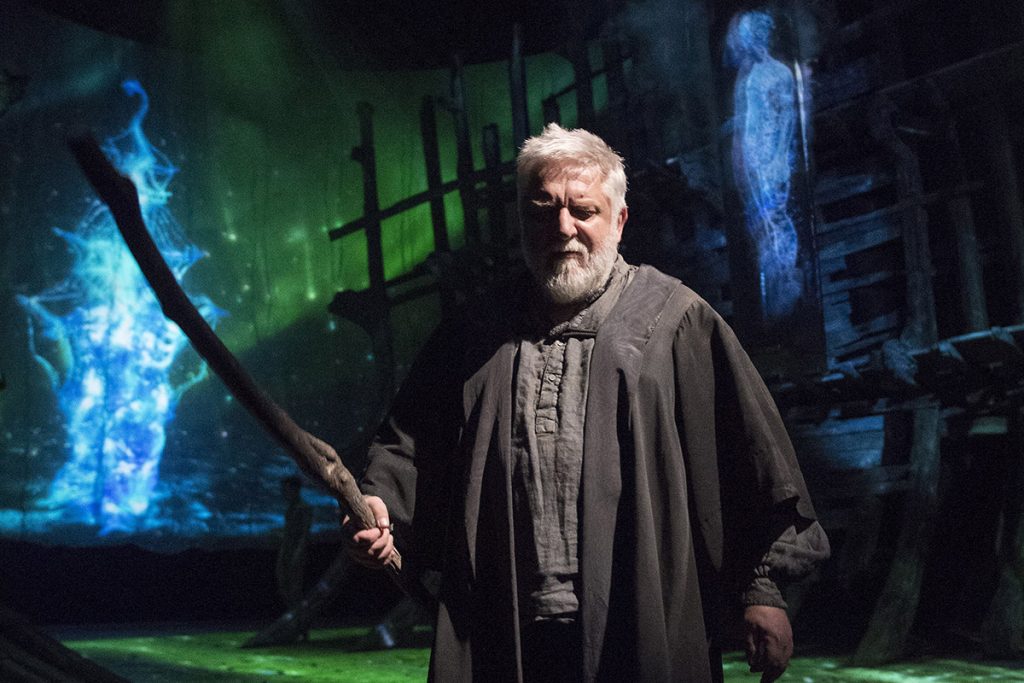
Here’s a review of the RSC’s production of The Tempest with Simon Russell Beale as Prospero. Through a combination of editorial tightening and big claims (I’m saying Shakespeare’s last play was a masque, not a drama) I make it appear here as though two fully grown polar bears once starred in its production. Please no one correct me: with a following wind this nonsense could become canonical.
for New Scientist, 21 November 2016
It should come as no surprise that the Royal Shakespeare Company’s projector and motion-capture-enhanced new production of Shakespeare’s last play is a triumph. For one thing, The Tempest is actually not a play: it is a masque, an almost-forgotten dramatic form that was contrived to blow millions (literally, if you convert into today’s currency) on effects-heavy entertainment meant for royalty and a few favoured hangers-on.
James I got his two fully grown pet polar bears involved in one memorable production; modern audiences get actor Mark Quartley as Ariel in a motion-capture extravaganza. The production uses an impressive array of sculpted net curtains as screens on which the serviceable sprite, though a real-enough presence on stage, also flies, dances, finds himself trapped in a tree, transforms into a harpy, and more or less realises every passing fancy about him that Shakespeare ever thought to put to pen.
There is no attempt to hide Quartley, who is also on stage while rigged up in motion-capture kit, rather like those puppeteers who don’t attempt to hide themselves during their performance.
The show is the fruit of a two-year collaboration between the Royal Shakespeare Company (RSC), IT company Intel and The Imaginarium Studios – a performance-capture house co-founded by actor Andy Serkis, who played Gollum in The Lord of the Rings film series.
The results are impressive but not seamless. When Quartley dances, Ariel flies. When he speaks or sings, Ariel’s bad lip-synching suggests the buggier corners of YouTube. Never mind: there are 200,000 files running at once to bring this illusion to life, and anyone who knows anything about the technology will be rightly astounded that the sprite responds in real time at all. Much of the two-year collaboration was spent turning a post-production technology into something robust enough for stage use. It is a tremendous, if hidden, achievement.
More seriously – though this is hardly a criticism – The Tempest is the first outing for a form of theatre that is still looking for its grammar. The performance’s game-engine-driven Ariel is shown from a floating, swooping viewpoint, sometimes from above, sometimes from below, sometimes crash-zooming towards us and in the next instant hurtling away – to not much emotional effect, it has to be said.
No one’s doing anything wrong here: we simply don’t know how to read mood into these images, any more than we knew how, at the beginning of cinema, to read the cuts between images. Stephen Brimson Lewis is the RSC’s director of design and his throw-everything-at-it approach here is exactly the right one. If The Tempest is a mess at times, it’s a glorious mess, and one from which future productions can learn.
Simon Russell Beale is Prospero, gamely preparing to be upstaged in journalistic copy, but never, ever on stage. Beale’s is a moving, mesmerising performance, full of rage and danger, though his nice line in bathos keeps him anchored in a show that’s played predominantly for comedy, manufactured stage business and some groan-inducing visual puns.
It’s hard to imagine actual plays benefiting from this up-to-the-minute son et lumière. But The Tempest, and the masque form as a whole, is far closer to opera than to drama, and that, I suspect, is where this technology will find a home.
Meanwhile – and I can’t quite believe I’m saying this – budding playwrights might seriously consider writing masques.
